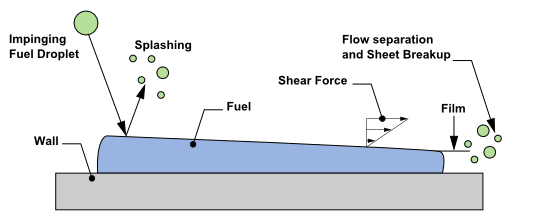The fundamental picture of a film model consists of a two dimensional thin film of liquid on a wall surface, as shown in Figure 17.1: Subgrid Processes That Require a Wall Film Model. A thin liquid film forms as liquid drops impinge on a solid surface in the domain. There are several possible outcomes from this impingement: stick, where the droplet impacts the wall with little energy and remains nearly spherical; rebound, where the drop leaves the surface relatively intact but with changed velocity; spread, where the drop hits the wall with moderate energy and spreads out into the film; and splash, where part of the impinging drop joins the film and another part of the drop leaves the wall in several other smaller drops.
The thin film assumption is one usually made in both Eulerian and Lagrangian film modeling approaches, specifically that the thickness of the film is small compared to the radius of curvature of the surface so that the properties do not vary across the thickness of the film and that films formed are thin enough so that the liquid flow in the film can be considered parallel to the wall, with an assumed quadratic shape. Further modeling assumptions are needed to close the problem.



